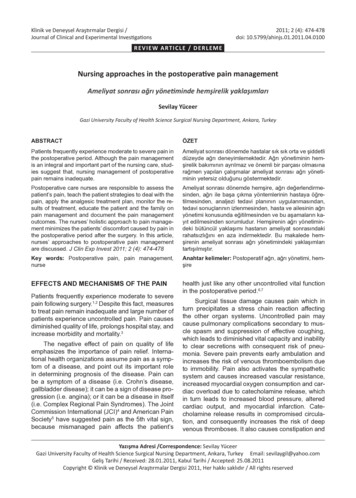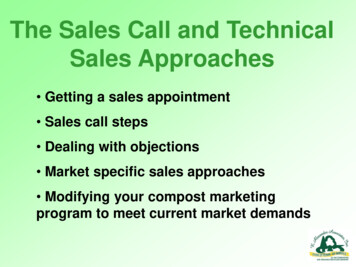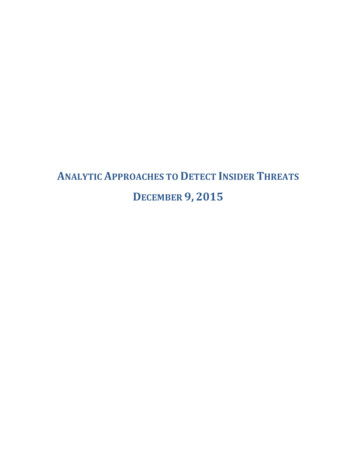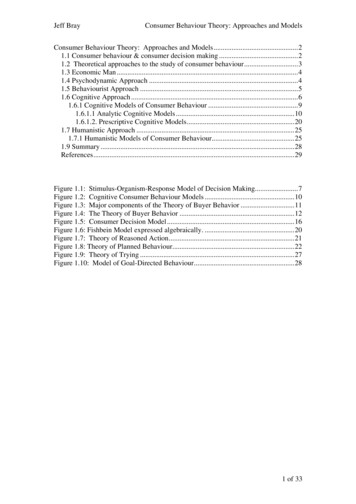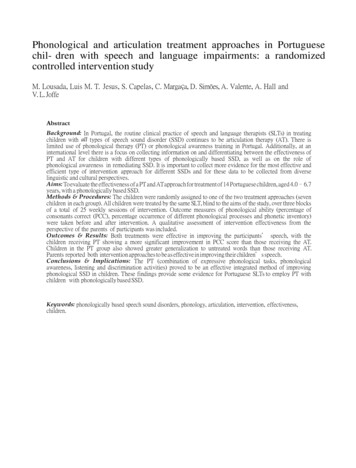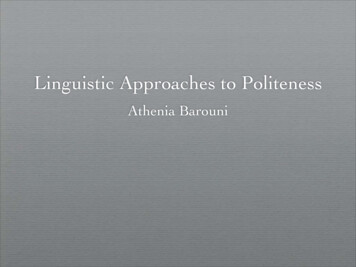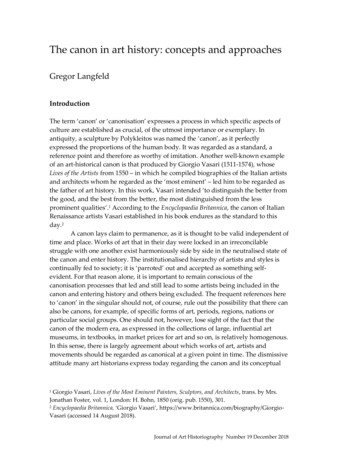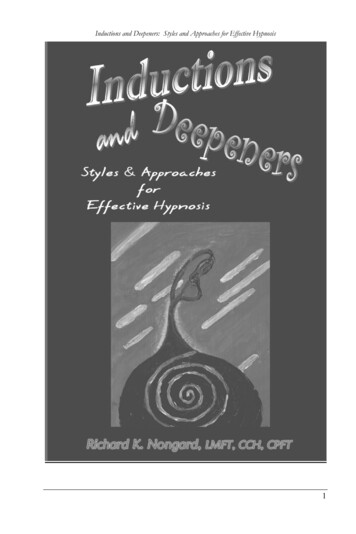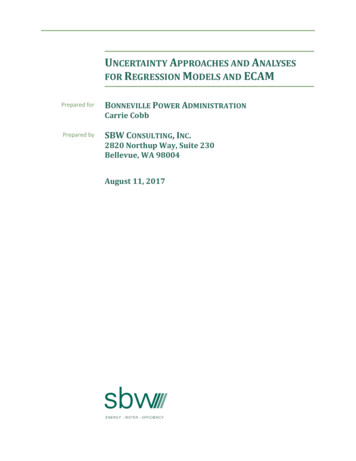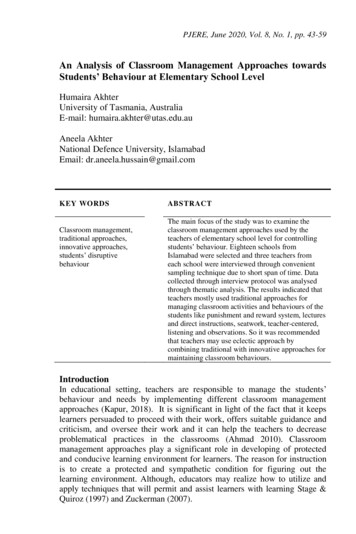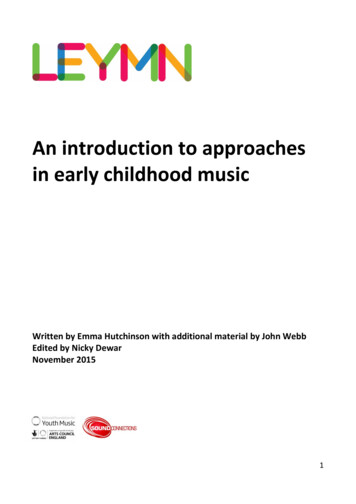
Transcription
An introduction to approachesin early childhood musicWritten by Emma Hutchinson with additional material by John WebbEdited by Nicky DewarNovember 20151
ContentsIntroductionPage 3Child-led music makingPage 4ColourstringsPage 6DalcrozePage 7GordonPage 8KindermusikPage 9KodalyPage 10MusikgartenPage 11OrffPage 12Sounds of Intent in the Early YearsPage 13SuzukiPage 14The Voices FoundationPage 152
IntroductionIn 2010 Sound Connections launched the London Early Years Music Network (LEYMN) for music leadersworking with very young children which aims to: encourage sharing of best practice, resources and information within the sectorbe a safe place to debate key issues referred from Network members and Sound Connections staff(e.g. pedagogic approach, quality of music, role of franchises, children’s musical development etc)be the first port of call for anyone looking for information on early years music making in Londonkeep abreast of other early years music networks’ activities regionally and nationallyadvise and be a critical friend to Sound Connections on its early years music strategy (training, tendersand project delivery)offer continuing professional development (CPD) opportunities to all music leadersThere are many different ways musical activities can be shaped, facilitated and delivered. This overviewintroduces some of these approaches and aims to help those new to the sector to better understand the worldof early years music making. For those who want to discover more we have included some suggested furtherreading.For LEYMN it is important that we recognise all approaches to early years music making, and we believe thatreflective, theory-based practice – that which considers how children learn and then is applied to practice – isat the heart of high quality musical experiences for children.We know there are a considerable amount of commercial franchised music activity in London and beyond.These have not been included here because of their vast number and because we know less about the theorybehind their work.This paper has been written by Emma Hutchinson from Music House for Children with additional text regardingchild-led music-making by John Webb. All information has been collated from different sources or from thewriter’s own experiences of the approach or method. Emma is a core member of LEYMN.3
Child-led music-makingChild-led music making places a child’s spontaneous, playful and creative music making at the heart of theirmusical learning, though it is an approach to be used in conjunction with adult-led musical activity, which mayitself spark children’s individual curiosity and exploration. So it is an approach which fits alongside the otherapproaches outlined in this booklet rather than replacing them. Its starting point is the best practice of earlyyears learning in which children choose activities in the setting and are allowed to freely explore these. Theadult’s role is to observe the child’s learning, to work out what they are interested in, and to extend andsupport learning in that area. This is achieved by playing alongside or with the child(ren) and providingactivities and resources which will extend the challenges available. In terms of understanding this approachone might explore, for instance, schemas and sustained shared thinking.Traditionally, music with young children has been based around an adult-led circle time – singing songs andperhaps playing instruments. But children often explore aspects of musicality through their self-directed playand it is the aim of the adult to spot and support these; it’s surprisingly easy to support the non-musical aspectsof children’s play and to miss the musical ones!Ways in which this may work include: Noticing sing-song like speech (or indeed spontaneous singing) and imitating it back to the child, orrecording it on a dictaphone so they can hear it back. This as the aural equivalent of sticking a picturethey’ve made on the wall. Playing percussion instruments with children, carefully following the speed, dynamics and rhythmsthey use. Children tapping or hitting objects inside and outside to discover their sounds: provide a range ofinteresting objects and beaters which could be used for further exploration; provide objects whichcan be made into sound makers in the recycled materials area. Extending play through improvised narrative songs about what a child is doing. This could characteriserole play (using different speeds and dynamics, for instance) or match rhythms the child isunconsciously using (when building a brick tower, for example). If the children respond to this bycreating their own songs/sounds follow this up through imitation.The approach embeds music making in everyday early years practice, and so can be hard for a music specialistto deliver if they have only a short time with a group. Ideally, it is a practice to be developed by musicspecialists and non-specialists alike, so that children’s spontaneous music making is noticed and supported.And, as Susan Young writes, it’s important that adults are flexible enough to take on a variety of roles inrelation to children’s music making:“The adult sometimes just needs to listen, to stand back and hear the child’s music, respond and comment.At other times it may be appropriate to join in and play with the children, partnering them in music playinteractions. At other times the adult may take the lead, perform and model for the children. So while I don’twish to diminish the value of adult-led music . Working with under-fours in music can cover a widespectrum of adult roles. Most important, these roles are fitted around children’s own ways of being musicalrather than the other way round.”Susan Young, Music with the Under-Fours, p19Useful literature and websites Early Years Foundation Stage Forum,. 'Developing Sustained Shared Thinking To Enhance The AreasOf Learning And Development; Prime Areas'. Evans, Nancy. 'Tuning In To Children: An Approach For Child-Led / Adult-Responsive Music Making Youth Music Network'. Network.youthmusic.org.uk. Web.4
Nutbrown, Cathy. Threads of Thinking: Young Children Learning and the Role of Early Education.London: Sage Publications, 2006. Print.Sound Connections for LEYMN. YouTube,. 'What's That Noise? Recognising And Supporting YoungChildren's Musicality'. 2013.Young, Susan. Music With The Under-Fours. London: RoutledgeFalmer, 2003. Print.5
Colourstrings (1972)A Hungarian musician and educator called Géza Szilvay (b. 1943) believed that children are able to learn musicfrom 18 months old, and should continue with the same principles and materials of learning up to 18 yearsold.Szilvay created the idea of a musical journey involving singing, clapping, marching and socialising using a widerange of musical activities together with composed songs. Much of his philosophy comes from Kodaly (page7) where he encouraged developing the inner ear through musical games, play and appropriate resources.All the activities are carefully devised to include different musical concepts of rhythm, pitch, melody,dynamics, tempo and style. By the time children reach five years old they are expected to be able to read astyle of music writing called ‘stick notation’. At this point children can opt to learn an instrument.The same music and songs are then explored through instrumental playing. The familiar songs are reassuringto older learners and help to adjust their early music learning to a new instrument. These songs are availablethrough Colourstrings Singing Rascals collection. The books are given to young children so they can enjoylooking at the illustrations before developing the ability to read and subsequently learn the music.Colourstrings provides training courses and INSET training to schools in the UK.Useful literature and websites Colourstrings.co.uk,. 'Colourstrings Homepage'. N.p., 2015. Web. Szilvay, Géza. Singing Rascals. London: Colourstrings, 1991. Print.6
Emile Jacques-Dalcroze (1865-1950)Dalcroze was an educator and philosopher in music education. During his teaching work at the GenevaConservatoire he noticed that musicians were not fully engaged together. In some cases they were simply notlistening to each other.Dalcroze realised that music needed to come from a physical connection as well as listening and playing. Heset out to create a new approach to understanding, listening and responding with activities involving musicand movement.By awakening both the mind and body through a new idea called ‘eurhythmics’ Dalcroze provided thepossibilities of musical understanding with very young children including those with additional needs. Oneexample of a well-known Dalcroze activity is to encourage young children to walk when they hear a regularbeat in a song such as ‘Baa baa black sheep’. The song was then repeated at a faster pace. In this way theteacher could demonstrate the basics of fast and slow.Lots of materials can be used to encourage the understanding of beat and other musical components ininteresting ways. These include balls, ribbons and scarves to encourage young children to participate. Manyearly years music teachers now apply the principles of Dalcroze to their teaching work since most areas ofmusical learning correlate with early learning goals.Training courses are available through the Dalcroze society’s website. The Dalcroze method continues to bewidely used and adapted across the world.Useful literature and websites Dalcroze.org.uk,. 'Dalcroze Home Page'. N.p., 2015. Web. Gell, Heather, and Joan Pope. Heather Gell's Lessons In Music Through Movement. Nedlands, W.A.:Published by CIRCME, The University of Western Australia in association with the Heather GellDalcroze Foundation, 1997. Print. Haselbach, Barbara. Dance Education. London: Schott, 1978. Print. Jaques-Dalcroze, Émile. Rhythm, Music And Education. New York: G.P. Putnam's Sons, 1921. Print. Mead, Virginia Hoge. Dalcroze Eurhythmics In Today's Music Classroom. New York: Schott, 1994.Print.7
Edwin E Gordon (1927-2015)Gordon created early musical experiences to provide a foundation for lifelong music development in youngchildren. In his work he explored the idea of ‘stages’ where children should be exposed to a variety of musicallearning as appropriate to their learning ability.Gordon’s musical activities include a range of music babble, much in the same way as babies vocalise inresponse to conversational patter that they hear. Gordon developed the idea of ‘unstructured informalguidance’ in his group music activities. These consisted of compositional games involving sound making andactivity. Together with parents, toddlers experience activities encouraging musical patter or babble.From three to five years children will engage in ‘structured informal guidance’. This means the adult and musiceducator make a plan on what the children will say and do, but do not enforce the responses.From the earliest beginnings of sound making, Gordon’s programmes provide activities within a rigorousprogramme of musical study. Each separate age group is broken down into the different areas ofunderstanding before they move onto the next level.More detailed information on Gordon’s methodology can be sourced from various websites. The GordonInstitute for Music Learning provides training for families and educators to help facilitate musicalunderstanding and delivery in young children.Useful literature and websites Giamusic.com,. 'Edwin E. Gordon Biography- GIA Publications'. N.p., 2015. Web.8
Kindermusik (1978)Founder of Kindermusik Dan Pratt established an early childhood music programme with resources, with theidea of supporting quality music learning in young children in nursery groups all over the world. He adoptedmany methods to perfect his package and since he started, Kindermusik has reached over a million childrenand their families.His programmes help children up to six years old enjoy a combination of music with movement, stories,instrumental exploration, dancing and singing. They are graded in order of age and ability. Sociable andcommunicative, gross and fine motor development are all emphasised as one of the main objectives and alsoinclude learning goals such as curriculum based outcomes including mathematics, literacy and language.The balanced set of activities aim to develop all the areas of learning, and families are encouraged toparticipate with lessons so they can continue with the activities at home.The training and accreditation of Kindermusik teachers is rigorous and detailed. Kindermusik has collatedinstrumental resources, digital music packages and a complete teaching programme to help nurture ongoingmusical experiences in young children.Useful websites and releases Freddie Flamingo and the Kindertown Five, an album by Kindermusik: Kindermusik International.Original Release Date: 1 Jan. 2006. Kindermusik.com,. 'Music Classes For Children And Schools Kindermusik'. N.p., 2015. Web. The Best of Kindermusik, an album by Kindermusik: Kindermusik International. Original ReleaseDate: 15 Jan. 2003.9
Zoltán Kodaly (1862-1967)Kodaly had a huge influence across Europe in his efforts to nurture and raise the standard of singing in youngchildren. He believed that children should be able to express themselves through their singing voice. Throughactive participation in singing and musical games children could develop an understanding of music from avery young age.Kodaly’s method incorporates the effective music system called solfège. Solfège involves assigning the notesof a scale a particular syllable starting from a low to a high sound. These syllables are known as:DoReMeFaSoLaTiKodaly believed that children learn best through engaging, fun musical games. Through a range of ageappropriate activities beat and rhythm were embedded as part of a child’s musical foundation. Games thatincorporated ‘Ta’ and ‘TiTi’ helped children to understand the musical terms ‘crotchet’ and ‘quave
Child-led music making places a child’s spontaneous, playful and creative music making at the heart of their musical learning, though it is an approach to be used in conjunction with adult-led musical activity, which may itself spark children’s individual curiosity and exploration. So it is an approach which fits alongside the other approaches outlined in this booklet rather than replacing .File Size: 725KBPage Count: 15
